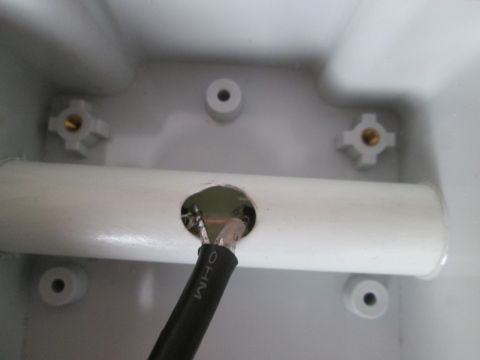
A bazooka is known to be nothing new, as monoband antenna but still unbeatable, in the home just, on the calculations
for the lengths, I'm not here an extra, which was and will be on various pages as well as in the literature to kick wide enough.
I have put special emphasis on the look. Fiberglass tube offers itself downright, the pictures speak more than 1000 typed words ...
Im Mittelteil ist das GFK Rohr
[ Pultrudiertes GFK Rohr aus glasfaserverstärkem Kunststoff ]
vorsichtig aufgebohrt, dort wird die Verbindung zur Speiseleitung hergestellt.
In the middle part is the GRP pipe
[ Pultruded GRP tube made of glass fiber reinforced plastic ] Drilled carefully so that there can be the connection to the feed line.
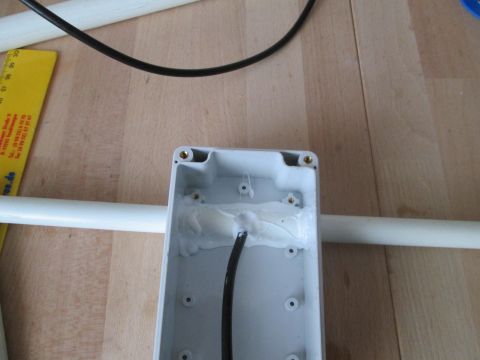
Anschließend schön dicht machen ...
Das hier verwendete Gehäuse ist übrigens ein "Industrie-Aufputz-Gehäuse IP65 Modell G258C"
www.reichelt.de "RND 455-00194" es geht natürlich auch die Version ohne transparenten Deckel, und je nach dem
auch kleiner...
Then close tight ...
Incidentally, the housing used here is an
"industrial surface-mounted housing IP65 model G258C"
alternative
www.reichelt.com "RND 455-00194" of course it is also the version without a transparent lid, and depending on the smaller...
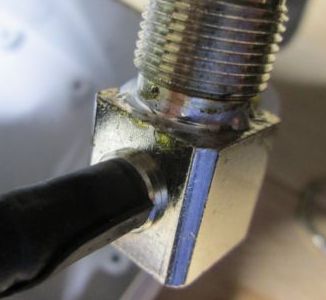
Bei Verwendung einer Kabelkupplung sollte diese wie auf dem Bild verlötet werden.
When using a cable coupling, it should be soldered as shown on the picture.
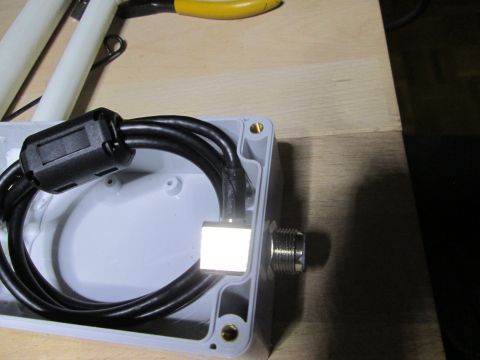
Eigentlich braucht eine Bazooka so etwas nicht!
Wer Mantelwellen komplett killen möchte macht das zum Beispiel so:
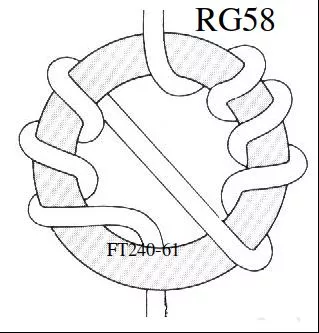
Lieber einen kleineren Ringkern FT 114-43 und dann RG174 damit es mit in das Gehäuse passt.
Hier sind der individuellen Kreativität keine Grenzen (außer den physikalischen) gesetzt.
That does not really need a bazooka.
Sheath waves, you destroy them too.
Better a smaller toroid FT 114-43 and then RG174 so that it fits into the housing.
Fast fertig.
Almost finished. Just adjust the ends of the antenna in the shacke before mounting on the mast. Mostly a further adjustment is not necessary.
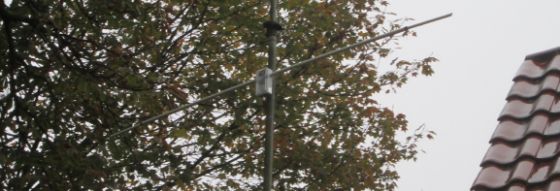
Fertig Montiert am Mast befestigt, Ready Mounted attached to the mast.
Hängt Ihn [Bazooka] höher !
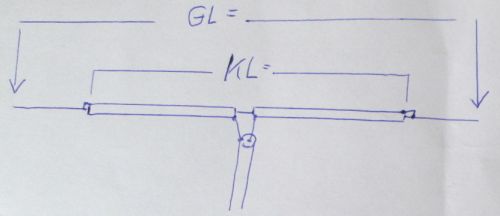
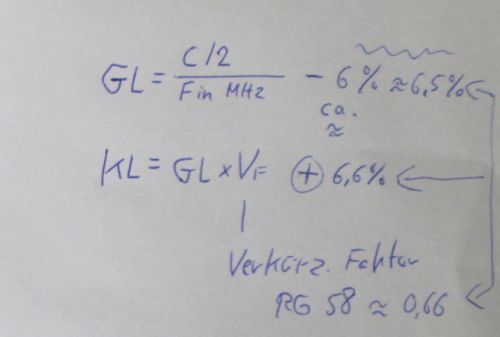
Hier Bezieht sich alles auf RG58/U !
Also recht einfach: GL steht für Gesamt-Länge und KL für Koax-Länge
C ist die Lichtgeschwindigkeit,
F ist Frequenz in MHz und
Vf steht für den Verkürzungsfaktor des verwendeten Koaxkabels.
Man nehme also für GL die halbe Lichtgeschwindigkeit geteilt durch die Frequenz in MHz,
entferne noch magische 6,6%
man hat dann an den Enden immer noch genug zum Abschneiden ;-)
Die Länge des Koaxkabels (KL) ist GL * Verkürzungsfaktor des verwendeten Koaxkabels, hier gern zuzüglich der Magischen 6,6%
C is the speed of light,
F is frequency in MHz and
Vf stands for the shortening factor [velocity ratio] of the coaxial cable used.
So for GL, take half the speed of light divided by the frequency in MHz,
remove another magical 6.6%
you still have enough to cut off at the ends ;-)
The length of the coax cable (KL) is GL * shortening factor of the used coax cable, here plus the Magic 6.6%
In meinem Fall für 6m bedeutet dies:
Gesamtlänge = Lichtgeschwinfdigkeit [schlampig 300 ] /2 = 150 / 50,5MHz abzüglich 6,6 % ergibt 2,774m (Meter)
Koaxlänge = 2,774m * 0,66 = 1,831m zuzüglich 6,6%.
In der Realität fertigt man also ein RG58 in der Länge von 1,95m an, bei welchem mittig der Schrirm aufgetrennt wird - und dort dann die Speisung erfolgt.
Anschließend verlängert man dann mit 1,5mm² CU die Enden auf die berechnete Länge GL,
dann umbiegen oder schnippeln... auf bestes SWR